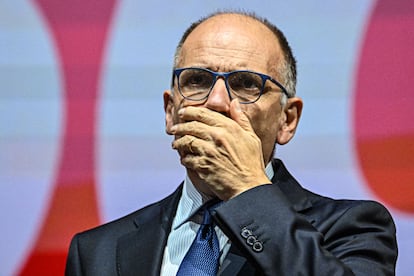Italy elections: How divisions on the left have benefited the right
Sunday’s contest reflects a realignment of progressive forces. Social democracy now represents the urban middle class, and other parties are emerging to defend workers

Italy’s elections on Sunday could lead to a right-wing government in the fascist tradition coming to power. If so, it would be the first time since World War II that such a government has been elected in either Italy or Europe. However, this is not so much the right’s victory as it is the left’s defeat. In fact, the overall percentages of support for the center-right and center-left have not changed much in recent months. However, the internal composition of the different coalitions has changed. On the center-right, Giorgia Meloni’s Brothers of Italy party, which came from the post-fascist Social Movement party, has surged, while Matteo Salvini’s La Liga has fallen in support. On the center-left, the Five Star Movement was declining as the Democratic Party (PD) made gains. Those positions have now been reversed: support for PD has fallen, while Five Star Movement has seen a boost. But the degree of unity or disunity among the different groups is what matters.
The center-right enters Sunday’s elections united, despite previous divisions between the government and the opposition. Giorgia Meloni deftly remained on the sidelines of Mario Draghi’s government, which has allowed her to tap into social discontent. But remaining aloof from the government didn’t stop her from forming a coalition with Berlusconi’s Forza Italia and Salvini’s La Liga. The center-right learned a long time ago how to sharply distinguish its own positions for maximum political effect – while sometimes engaging in internal disputes – to then form alliances with those they’d bitterly disagreed with in the past. On the center-left, however, the Five Stars Movement and PD are running separately in these elections even though both formed part of the government. That division will have a significant impact on the outcome of Sunday’s elections. The Rosatellum electoral system – named after former PD politician Ettore Rosato and Renzi who drafted the electoral law – greatly rewards coalitions. That means that, despite having more votes overall, the divided center-left will not have enough to win a majority of seats.
That division is not just a tactical issue. It’s a structural condition that reflects the chasm between the different classes and social categories that the different parties represent. The Democratic Party was supposed to be the party of social democracy and represent workers. After all, it is the heir to the Italian Communist Party (PSI) and left-wing Christian Democracy. But today it is the most bourgeois party; its highly educated electorate is concentrated in large urban centers and has white-collar, professional and managerial occupations. Workers who used to vote for the PCI and Italian Socialist Party (PSI) are now pensioners who vote for the PD, while their children tend to have middle-class professions and occupy a position of relative wealth. At the same time, the PD has left the working-class electorate – those who work for very low wages and those who live in abject poverty – a group concentrated in southern Italy. The Five Star Movement appeals to those very people, and it offers them measures like citizens’ income, a social welfare system that is similar to universal basic income. In other words, the Five Star Movement has gone after an electorate that normally would have voted for a social democratic option, but now there is none.
During the electoral campaign, Giuseppe Conte, the former prime minister and current leader of the Five Star Movement, emphasized the social aspect of his party. He made his campaign slogan “on the right side,” harshly attacked politicians – like Matteo Renzi – who want to eliminate the citizens’ income, and adopted buzzwords reminiscent of US Democrat Bernie Sanders and the UK Labour Party’s Jeremy Corbyn. Conte’s rallies have packed plazas with supporters, especially in southern Italy, where the economic conditions are the harshest. The Five Star Movement has surged at the polls and now threatens to overtake the Democratic Party. This situation has forced the PD’s Enrico Letta, who initially pursued a centrist strategy, to switch to more progressive promises, such as public sector hiring and protecting public services. But that strategy has seemed indecisive and insincere, especially because Letta had presented himself at the beginning of the campaign as the candidate who would support a new Draghi government to maintain stability and the system. Thus, the Italian situation reflects a realignment of center-left forces that isn’t unique to Italy; it’s happening all around the world. Old social-democratic forces have become middle-class ones; they are now in danger of losing working-class support. They are also being pressured from the left, or rather “from below,” by new populist forces that present themselves as the true defenders of the people’s interests. The risk of reshaping the center-left is that the right will win, which is likely to happen in Italy on Sunday.
Tu suscripción se está usando en otro dispositivo
¿Quieres añadir otro usuario a tu suscripción?
Si continúas leyendo en este dispositivo, no se podrá leer en el otro.
FlechaTu suscripción se está usando en otro dispositivo y solo puedes acceder a EL PAÍS desde un dispositivo a la vez.
Si quieres compartir tu cuenta, cambia tu suscripción a la modalidad Premium, así podrás añadir otro usuario. Cada uno accederá con su propia cuenta de email, lo que os permitirá personalizar vuestra experiencia en EL PAÍS.
¿Tienes una suscripción de empresa? Accede aquí para contratar más cuentas.
En el caso de no saber quién está usando tu cuenta, te recomendamos cambiar tu contraseña aquí.
Si decides continuar compartiendo tu cuenta, este mensaje se mostrará en tu dispositivo y en el de la otra persona que está usando tu cuenta de forma indefinida, afectando a tu experiencia de lectura. Puedes consultar aquí los términos y condiciones de la suscripción digital.
More information
Últimas noticias
Most viewed
- Reinhard Genzel, Nobel laureate in physics: ‘One-minute videos will never give you the truth’
- Oona Chaplin: ‘I told James Cameron that I was living in a treehouse and starting a permaculture project with a friend’
- Pablo Escobar’s hippos: A serious environmental problem, 40 years on
- Charles Dubouloz, mountaineering star, retires at 36 with a farewell tour inspired by Walter Bonatti
- Why we lost the habit of sleeping in two segments and how that changed our sense of time









































